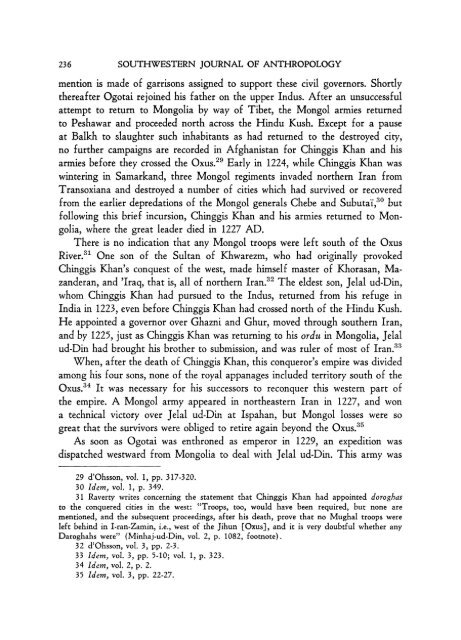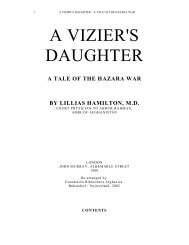The Inquiry into the History of the Hazara Mongols of ... - Hazara.net
The Inquiry into the History of the Hazara Mongols of ... - Hazara.net
The Inquiry into the History of the Hazara Mongols of ... - Hazara.net
You also want an ePaper? Increase the reach of your titles
YUMPU automatically turns print PDFs into web optimized ePapers that Google loves.
236<br />
SOUTHWESTERN JOURNAL OF ANTHROPOLOGY<br />
mention is made <strong>of</strong> garrisons assigned to support <strong>the</strong>se civil governors. Shortly<br />
<strong>the</strong>reafter Ogotai rejoined his fa<strong>the</strong>r on <strong>the</strong> upper Indus. After an unsuccessful<br />
attempt to return to Mongolia by way <strong>of</strong> Tibet, <strong>the</strong> Mongol armies returned<br />
to Peshawar and proceeded north across <strong>the</strong> Hindu Kush. Except for a pause<br />
at Balkh to slaughter such inhabitants as had returned to <strong>the</strong> destroyed city,<br />
no fur<strong>the</strong>r campaigns are recorded in Afghanistan for Chinggis Khan and his<br />
armies before <strong>the</strong>y crossed <strong>the</strong> Oxus.29 Early in 1224, while Chinggis Khan was<br />
wintering in Samarkand, three Mongol regiments invaded nor<strong>the</strong>rn Iran from<br />
Transoxiana and destroyed a number <strong>of</strong> cities which had survived or recovered<br />
from <strong>the</strong> earlier depredations <strong>of</strong> <strong>the</strong> Mongol generals Chebe and Subutai,30 but<br />
following this brief incursion, Chinggis Khan and his armies returned to Mongolia,<br />
where <strong>the</strong> great leader died in 1227 AD.<br />
<strong>The</strong>re is no indication that any Mongol troops were left south <strong>of</strong> <strong>the</strong> Oxus<br />
River.31 One son <strong>of</strong> <strong>the</strong> Sultan <strong>of</strong> Khwarezm, who had originally provoked<br />
Chinggis Khan's conquest <strong>of</strong> <strong>the</strong> west, made himself master <strong>of</strong> Khorasan, Mazanderan,<br />
and 'Iraq, that is, all <strong>of</strong> nor<strong>the</strong>rn Iran.32 <strong>The</strong> eldest son, Jelal ud-Din,<br />
whom Chinggis Khan had pursued to <strong>the</strong> Indus, returned from his refuge in<br />
India in 1223, even before Chinggis Khan had crossed north <strong>of</strong> <strong>the</strong> Hindu Kush.<br />
He appointed a governor over Ghazni and Ghur, moved through sou<strong>the</strong>rn Iran,<br />
and by 1225, just as Chinggis Khan was returning to his ordu in Mongolia, Jelal<br />
ud-Din had brought his bro<strong>the</strong>r to submission, and was ruler <strong>of</strong> most <strong>of</strong> Iran.33<br />
When, after <strong>the</strong> death <strong>of</strong> Chinggis Khan, this conqueror's empire was divided<br />
among his four sons, none <strong>of</strong> <strong>the</strong> royal appanages included territory south <strong>of</strong> <strong>the</strong><br />
Oxus.34 It was necessary for his successors to reconquer this western part <strong>of</strong><br />
<strong>the</strong> empire. A Mongol army appeared in nor<strong>the</strong>astern Iran in 1227, and won<br />
a technical victory over Jelal ud-Din at Ispahan, but Mongol losses were so<br />
great that <strong>the</strong> survivors were obliged to retire again beyond <strong>the</strong> Oxus.35<br />
As soon as Ogotai was enthroned as emperor in 1229, an expedition was<br />
dispatched westward from Mongolia to deal with Jelal ud-Din. This army was<br />
29 d'Ohsson, vol. 1, pp. 317-320.<br />
30 Idem, vol. 1, p. 349.<br />
31 Raverty writes concerning <strong>the</strong> statement that Chinggis Khan had appointed doroghas<br />
to <strong>the</strong> conquered cities in <strong>the</strong> west: "Troops, too, would have been required, but none are<br />
mentioned, and <strong>the</strong> subsequent proceedings, after his death, prove that no Mughal troops were<br />
left behind in I-ran-Zamin, i.e., west <strong>of</strong> <strong>the</strong> Jihun [Oxus], and it is very doubtful whe<strong>the</strong>r any<br />
Daroghahs were" (Minhaj-ud-Din, vol. 2, p. 1082, footnote).<br />
32 d'Ohsson, vol. 3, pp. 2-3.<br />
33 Idem, vol. 3, pp. 5-10; vol. 1, p. 323.<br />
34 Idem, vol. 2, p. 2.<br />
35 Idem, vol. 3, pp. 22-27.



